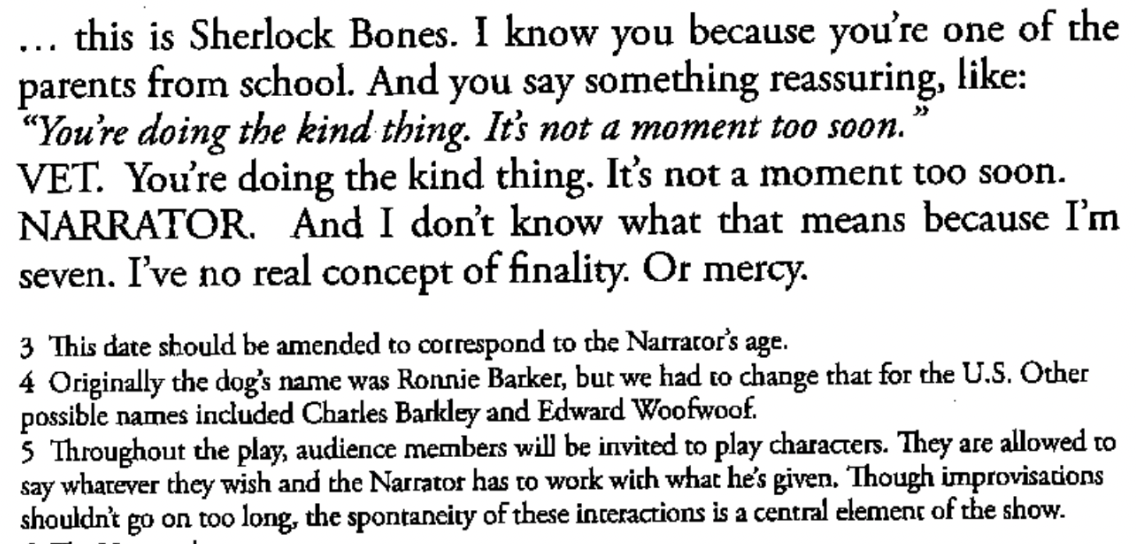A Life of Its Own: The Incredible Journey of Every Brilliant Thing
Every Brilliant Thing began its life as a 15-minute monologue titled Sleeve Notes, a term for the writings found on the sleeves of an album, more commonly called liner notes here in America. English playwright Duncan Macmillan wrote the piece for an actor friend of his, Rosie Thomson, who had performed in an earlier play of Macmillan’s but had no lines. Writing Sleeve Notes for her was the playwright’s way of returning the favor. Thomson performed the monologue for the first time in 2006 and continued to perform it over the next few years.
Meanwhile, Macmillan was invited to perform something he’d written at an event hosted by Paines Plough, a British touring theatre company dedicated to new work, and the playwright chose to read Sleeve Notes himself for the first time. Director George Perrin saw Macmillan’s performance and was incredibly moved by the piece. He and Macmillan began discussing how the piece could evolve, and they decided to actually create the entire list of brilliant things referenced in the story. They wanted the list creation to be a collaborative process, with anyone able to add to the list, and so they created a Facebook group and began to share it. Within a few months, the group had several hundred members and almost a thousand list items.
As the monologue continued to be performed live, audience members were invited to write down and contribute list ideas, which were then gathered and added to the Facebook group. Macmillan and Perrin invited designers Paul Burgess and Simon Daw to begin collaborating on the project, and the two designers transposed all the entries in the Facebook group on to physical objects like envelopes, post-it notes, receipts, cardboard, etc. The list items were then installed into an art exhibit in a tent where audiences could peruse them while a performer read the monologue aloud. When the project was brought to the Latitude Festival in 2009, a host of performers would alternate reading the monologue every 15 minutes for 4 straight days. The exhibit was a great success and people continued to express to Macmillan and Perrin how good they felt the story could be for mental health awareness and education.
While working on another show of Macmillan’s in 2012, Perrin and the playwright picked up the conversation about Every Brilliant Thing again. The two invited Jonny Donahoe to join them in collaborating on turning the monologue into a full-length play. Donahoe’s background in comedy and improvisation would be instrumental in devising the defining characteristic of the play: its audience participation.
“We wanted it to be a conversation with the lights on. Everyone could see each other, everyone could hear each other, and everyone could laugh and cry together,” Macmillan explained in a 2015 interview. “The word we kept using was the ‘gesture’ of the piece, as in, let’s not separate us from the audience; let’s do everything together. […] It’s a scary, dark subject that we didn’t want to sentimentalize, but we also wanted to be really honest and helpful about it. […] It had to be funny, and it also needed to be open and generous and inclusive of an audience and not scare people off.”
The full-length version of Every Brilliant Thing debuted in 2013 with Donahoe as a performer and it became a breakout hit at the Edinburgh Fringe Festival in 2014. Later that year, the production was invited over to New York for a four-month off-Broadway run at the Barrow Street Theatre. While performing in New York, an HBO Documentary film crew recorded several performances and the recording debuted on the MAX streaming service in 2016 where it is still available for viewing.
The published version of the script passes along a lot of the expertise Macmillan, Perrin and Donahoe acquired during their long journey of devising the play and performing it live. Almost every page includes a footnote with some insight or recommendation on how the performer can navigate the unpredictability of a live audience asked to participate. Here’s an example of how that knowledge is conveyed on the page:

Donahoe continued to perform the piece on tour for another two years. Since 2017, when the play was published and the rights made available for theatres to stage their own productions, Every Brilliant Thing has exploded in popularity. There have now been productions in over 60 countries, with at least 400 professional productions and many more amateur ones. The script also makes clear that the creators want new productions to update references and wordings to suit the location and community in which the play is being performed, with Donahoe saying in an interview: “It’s really important that people do their own versions. It’s not a museum piece.”
This past summer, ten years after the play made its Edinburgh debut, Macmillan and Donahoe teamed up again to bring Every Brilliant Thing back to the Fringe Festival. Donahoe stepped back into the role he helped shape for the first time in years, and Macmillan directed. The Guardian called the show “theatre’s best antidote to depression,” a remarkable accolade for what its author once referred to as “the least cool piece of theatre ever, in some ways.” And yet the message Macmillan strove to convey in every iteration of this story still resonates. “You’re not alone, you’re not weird, you will get through it, and you’ve just got to hold on. That’s a very uncool, unfashionable thing for someone to say, but I really mean it.”